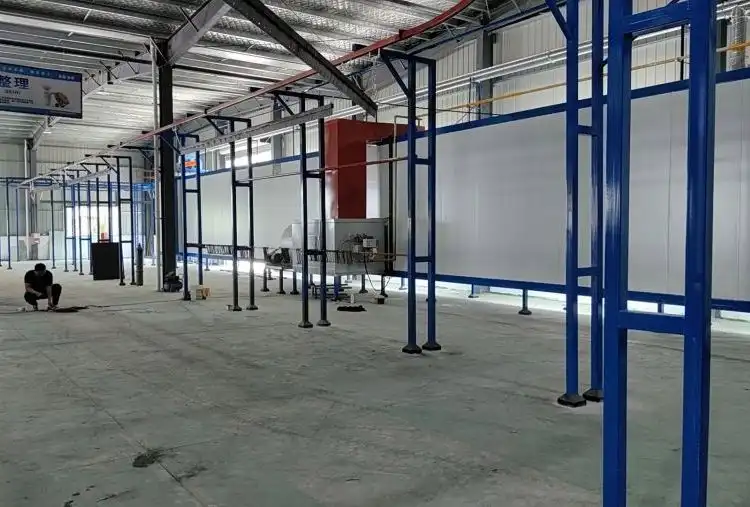
How to deal with the burnt edge of electrostatic spraying
How to deal with the burnt edge of electrostatic spraying
Burnt edges during **electrostatic spraying** are typically caused by **excessive voltage**, **incorrect gun distance**, or **poor coating technique** that leads to overheating or overexposure of the coating on edges. These “burnt” edges can manifest as areas with **too much paint**, **uneven coating**, or even **discoloration**. Here’s how you can address and prevent burnt edges:
—
### **1. Adjust the Electrostatic Voltage**
– **Lower the Voltage:** High electrostatic voltage can cause **excessive paint accumulation** on edges. Reducing the voltage (e.g., **from 90kV to 60-70kV**) can help ensure a more even distribution of paint.
– **Gradually fine-tune the voltage** based on the coating material, part shape, and desired finish. Too high a voltage will concentrate paint on edges and corners.
—
### **2. Increase the Gun-to-Workpiece Distance**
– **Increase the Distance:** The closer the spray gun is to the surface, the more the paint will be concentrated on the edges, especially due to electrostatic attraction.
– Ideally, keep the spray gun **at least 8–12 inches** from the surface to reduce the buildup on edges. Experiment with adjusting the distance for the best results.
—
### **3. Modify the Spray Angle and Pattern**
– **Avoid Direct Angle on Edges:** When spraying, **angle the gun slightly** to avoid spraying directly onto edges. Spraying slightly off to the side will help ensure an even distribution across the surface, preventing excessive buildup on edges.
– **Use a Crosshatch or Circular Motion:** Using a cross-coating or circular motion can prevent the edges from getting hit too hard in one pass, which can lead to burning.
—
### **4. Fine-Tune Airflow and Atomization**
– **Adjust Air Pressure and Atomization:** If the airflow or atomization is too low, the paint particles will be larger and more prone to uneven deposition, especially on edges. Increase the **air atomization pressure** to achieve a finer mist and reduce the chance of large paint droplets building up on the edges.
– Use **appropriate paint viscosity** and ensure that it is properly mixed. Thicker paint might need more atomization to distribute properly.
—
### **5. Use Pre-Coating or Edge Masking**
– **Edge Masking:** Use **masking tape** or **shields** to cover the edges of your part before spraying. This helps to prevent overspray buildup at the edges and creates cleaner transitions between areas.
– **Pre-Coat Edges:** If you are spraying a large part, try applying a **light coat** to the edges first, allowing them to dry before applying the main layer. This can help avoid excessive accumulation on the edges during the main spraying phase.
—
### **6. Control Booth Conditions**
– **Temperature and Humidity:** Ensure the spray booth is kept at the proper **temperature (around 65–75°F)** and **humidity (40–60%)** to prevent paint from curing too quickly or too slowly, which can exacerbate the problem.
– Ensure that **ventilation is adequate** to prevent hot spots and ensure that the air is consistently circulating.
—
### **7. Sanding or Light Buffing (Post-Application)**
If the burnt edges are already present, here are ways to fix them:
– **Light Sanding:** Once the coating is completely dry and cured, use a **fine-grit sandpaper (600–1000 grit)** to gently sand down the burnt edges. This smoothens out excess buildup and blends the edges with the rest of the surface.
– **Buffing:** After sanding, you can use a **polishing compound** or **buffing wheel** to smooth out any imperfections, especially on gloss finishes.
—
### **8. Experiment with Electrostatic Spray Settings**
– **Try Different Spray Guns:** Different electrostatic guns have different spraying patterns, so experimenting with a **gun that offers more control** over the spray pattern can be helpful in minimizing burnt edges.
– **Test Spray Parameters:** Test various parameters such as **voltage, distance, air pressure**, and **fluid flow** on sample parts to find the optimal settings for your specific coating material and part geometry.
—
By carefully adjusting the **voltage**, **spray distance**, **air pressure**, and **spray technique**, you can reduce the likelihood of burnt edges and achieve a more uniform and professional finish. If you’re still facing issues, you might also consider **upgrading to a more advanced electrostatic system** that offers better control over spray patterns and charge distribution. Would you like help with settings for a specific type of material or spray system?
electrostatic powder coating equipment suppliers
electrostatic powder coating hazards
electrostatic powder coating hs code
electrostatic powder coating las vegas
electrostatic powder coating line factory
electrostatic powder coating machine company
electrostatic powder coating machine hs code
electrostatic powder coating machine manufacturer
electrostatic powder coating machine price
electrostatic powder coating machine products
electrostatic powder coating machine supplier

